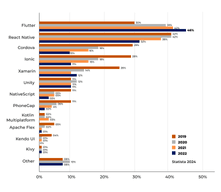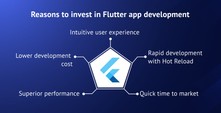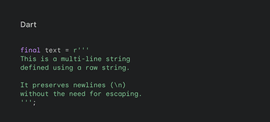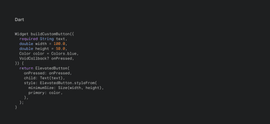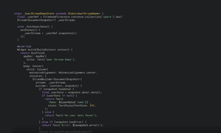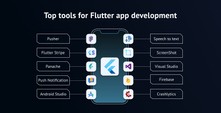Quick Summary: Discover the detailed facts about Flutter app development in our comprehensive guide. Learn proven strategies, address challenges, and explore real-world use cases to master this multifaceted framework. Whether you are a startup, enterprise, or developer, this guide empowers you with the necessary knowledge and techniques to successfully develop a cross-platform application with native functionality.
The mobile app development sector has grown significantly over the last few years. With more people choosing their smartphones as their primary mode of interaction and accessing a wealth of information in a single tap, enterprises are mandated to develop applications that address end-user needs. That is how Flutter has emerged and opened avenues for building cross-platform applications for different industries.
As a cross-platform framework, Flutter offers a myriad of benefits for app development. According to Statista, 46% of developers prefer the Flutter framework over others. Developers worldwide have widely accepted the framework; therefore, there is an iteration of updated versions of Flutter, the most recent of which is Flutter 3.27.
This open-source framework has been transforming the mobile app development dynamics since 2017 and expanding businesses’ potential to connect with target audiences. So, today, let’s discuss the significance of Flutter app development, its proven strategies, challenges, and use cases that validate its unrivaled competency.
Reasons to choose the Flutter framework
Flutter 3.27 accelerates app development, minimizes cost, and helps develop apps with interactive design and smooth animations. This latest Flutter version, 3.27, brings many updates across the framework, engine, and ecosystem, such as the impeller as the default rendering engine on Android and support for edge-to-edge mode on Android 15+. Moreover, Dart 3.6, released alongside Flutter 3.27, brought in the pub workspace, enabling Flutter Analyzer to process all the packages in the pub workspace in a single analysis context.
Besides that, digital separator addition offers better readability for large numbers. Above all, the Flutter AI toolkit offers ready-to-use AI chat widgets, which are designed to integrate smoothly into your Flutter projects. So, let’s review more reasons that will help you substantiate the Flutter framework to build your next application.
Single codebase & multiple platforms
With the Flutter framework, developers write code once and deploy it across platforms like Android, iOS, and the web. It saves developers time as the Flutter framework utilizes Google’s in-house language, Dart, which significantly increases developers’ productivity and saves development time.
Quick development with Hot Reload
Flutter’s Hot Reload feature is globally acclaimed. It allows developers to view modified code instantly without rebuilding the entire application, accelerating the Flutter app development process and overall productivity.
Read also: How Flutter app development can be a perfect fit for your project?
Rich UI
Flutter facilitates a vast pool of customizable widgets and material design elements that allow developers to create engaging and interactive user interfaces. Even complex user interface design implementation becomes smooth with this framework’s flexibility.
Strong community support
Across the globe, Flutter has an active developer community that contributes to its ecosystem by developing packages, plugins, and comprehensive documentation. This widespread support network aims to help developers troubleshoot issues and find the best-fit solutions to the most common problems.
Native feature accessibility
Flutter facilitates plugins that allow access to native device features like sensors, cameras, GPS, and more to developers. It allows the building of fully functional applications leveraging the maximum capabilities of the fundamental platform.
Excellent documentation
For developers, beginning with Flutter app development is easy as Google offers all the needed documentation, tutorials, and resources. Besides that, many active communities, forums, and meetups are dedicated to Flutter development globally that assist developers.
Cross-platform compatibility
Like other frameworks, Flutter does not require the application elements to be adjusted according to the platform. Flutter assures consistent behavior and looks across different platforms. It eliminates complexities associated with development and maintenance and allows developers to concentrate on writing code rather than being distressed about platform dissimilarities.
Top business cases where Flutter better utilized
Big brands and startups have gradually begun to realize the potential of Flutter app development services, as their popularity is consistently booming. So, let’s look closely at the business cases where Flutter’s elasticity, scalability, and resilience are highly efficient.
Cross-platform app development
Flutter is a robust tool for building cross-platform applications and can be leveraged in the following settings.
With Prefixed deadlines
Flutter, the cross-platform solution, accelerates the development process and helps achieve prefixed deadlines as it allows the usage of a single codebase across the chosen OSs, like Android and iOS platforms. It improves development speeds by an average of 30%, and Flutter-based applications give a native feel and look with minimum effort.
To Test concepts
If your business needs to adapt dynamically to shifting market trends, the Flutter framework helps test the concept before creating a fully functional application. It allows you to change the app logic dynamically without making significant modifications. You can seamlessly add interactive widgets, native elements, and animations according to your target audience preferences and simultaneously change the application logic across all platforms. It eliminates the need to rewrite platform-specific codes.
For intricate custom design
Flutter app development is particularly beneficial when you require an application with intricate and custom design. It is an ideal solution for creating complex interfaces that too with rapid development cycle. It also allows you to integrate third-party services and other technologies.
Web development
Flutter is best-fit choice for developing web applications in the following scenarios:
- If you choose to migrate your existing applications from mobile to web because of 100% code sharing.
- Like IDEs and editors, when building intricate and dynamic web interfaces.
- When you want to build a pool of functionality for multifaced enterprise solutions with prefixed deadlines.
As Flutter code can be aggregated into Webassembly for optimized performance and security in intricate design cases, it is very likely to have the same codebase for desktop, iOS, Android, and other web versions of the app.
The latest Flutter 3.10 version brings a wealth of advantageous features and improvements that promise improved user engagement. However, with this notable development, there is still room for growth concerning compatibility, as per the records facilitated by the Flutter strategy team. It is necessary to overcome constraints and adopt Flutter within a web-based project more easily.
Apps with native-dependent functionality
Flutter app development company enables you to embed native views and apply transforms, copy, and opacity to the native view from Dart. You can also use the native elements from the Android or iOS SDK directly in your Flutter app. As native plugins are steadily expanding, Flutter allows building mobile applications for Android and iOS platforms without demanding extensive knowledge of the native parts.
If you wish to customize the camera, you need to make the necessary changes in the native plugin with the help of iOS and Android developers, as it is not available with ready-made plugins.
Apps with superior stability
With Flutter rendering engines and the capability to compile code into CPU-specific ARM code, it is the best framework for keeping the interface stable during operating system customizations and updates. With this stability, a few industries would benefit the most, such as transportation, finance, healthcare, and eCommerce.
Flutter framework-based applications function smoothly because Flutter offers a higher degree of stability. A few technologies may no longer support older versions following the specific timeframe. However, Flutter ensures compatibility and sustains the persistent API and development approach. This implies you can reuse the code in a new application that was developed in an earlier version while assuring compatibility with new applications, too.
MVP development
Flutter is a perfect choice for MVP development because of its dynamic characteristics that optimize developers’ productivity. Developers can quickly refine and change the code without requiring the application to be restarted entirely. Since Flutter widgets are unalterable, only the screen undergoes a reloading process, as only the screen is actively worked on.
As per the research, this approach substantially reduces the development time by roughly 30 to 35%.
With a wide-ranging ecosystem of plugins, Flutter offers added capabilities. However, it is essential to note that not all plugins may remain compatible with the newest Flutter version. Thereafter, it is essential to evaluate and audit third-party plugins. It assures swift functionality in MVP. You can hire Flutter developers to create MVP, understand how your target audience perceives your product, and make necessary modifications while building fully functional applications.
Desktop app development
Flutter enables you to augment your macOS, Linux, and Windows applications, utilizing the OS-specific APIs and desktop ecosystem libraries. However, the team must make additional attempts to stimulate the features of your mobile app on the desktop.
Moving from mobile to desktop UI necessitates meticulous adjustment. Desktop applications are often coupled with dynamic interaction models, with accurate mouse control and comprehensive keyboard input. Successfully adapting mobile UI to the desktop requires reevaluating the navigation process, control sizes, and layout structure to ensure it is smoothly incorporated into the desktop.
Migrating existing apps to Flutter
Small to big enterprises acknowledge the strategic significance of converting their native applications to Flutter. Big corporations like Alibaba and Philips Hue have already converted their native apps to Flutter frameworks, accelerating the development cycle and significantly improving user experience.
Migration of your Android and iOS application to a Flutter-based cross-platform environment streamlines the product support process and further development by eradicating the need to employ different development teams. This approach is specifically beneficial when your iOS and Android applications share similar logic. This approach facilitates better adaptability to aim new platforms or devices at the lowest possible development efforts.
You can migrate your native application to the Flutter environment by following the three strategies below.
Add Flutter library or module to native apps
This approach allows you to embed new features into existing native applications without interrupting the development process. However, it is essential to work with a native app development expert to determine the appropriate execution of embedding new features.
Adding native app elements
For this strategy, you need to form a communication strategy to transmit messages from native to Flutter and back and forth. However, it increases the code base intricacies but enables seamless transition without disrupting the current development.
Rewrite native apps entirely
If you choose this approach, you are not required to configure communication between cross-platform and native projects. You gain unlimited access to Flutter features.However, to rewrite the native application entirely, you need to hire Flutter app developers.
Determining the best-fit strategy relies on factors such as the existing application structure, clients’ budget, native feature dependencies, etc. Migrating the native application to Flutter requires a careful strategy consisting of the required features and scope and forming a skilled development team with relevant expertise in native and Flutter frameworks. Besides that, a proven QA strategy is necessary to predict issues throughout the conversion process and ensure an immersive and engaging UX.
Proven strategies for Flutter app development
To simplify the Flutter app development process and allow developers to create natively compiled applications from a single code, let’s understand and learn the best practices for optimizing code quality, rendering, maintainability, readability, and productivity. Let’s make the most out of the Flutter framework.
Comprehend the Flutter constraints concepts
Every developer must understand that Flutter layout constraints fluctuate, and the parent adjusts the position. Widgets have their constraints from parents, which are known in four sets of doubles: a minimum and maximum width and height.
Widgets have their own children and sequentially go through and command their children what their constraints are. They ask every child what size they want to be.
The constraints are unique for each child. Afterward, the widget positions its children horizontally on the x-axis and vertically on the y-axis sequentially. Afterward, the Widget notifies parents about its size in original constraints.
In the Flutter framework, all widgets turn themselves based on the parent and box constraints but with some limitations. The widget must not have its size; its size has to be according to the constraints laid by its parent.
Utilize raw string
Utilize raw string to avoid backlash in regex patterns; it makes your code less readable and susceptible to faults.
Create a unique build function
The Flutter framework calls this method whenever the widgets are embedded into the tree at the designated BuildContext when the dependencies change. The build strategy is created in a unique way and without unwanted stuff as particular external factors spark a new widget build, like,
- Screen resize due to the keyboard look or orientation change
- Reroute push
- The parent widget recreated its child
- An Inherited Widget the widget depends on (Class. of(context) pattern) change
Logical use of operators
The operators are specific symbols that conduct particular operations on the operands. The Dart-based Flutter framework has built-in operators that can be employed to perform various functions.
- Use Null Safe and Null aware operators
- Use cascade operator
- Instead of the “as” operator use “is” operator
- Use spread collections
Use stream on-demand
Flutter inherits the stream as it is part of Dart. There are two parts: single subscription streams and broadcast streams. Since streams are powerful, it is essential to use them effectively. Utilizing them with inferior implementation results in more memory and CPU usage. By chance, if you miss turning off the stream, it results in memory leaks.
Against such instances, avoid using Streams and use something that consumes less memory, like ChangeNotifier for the reactive user interface. If you require more advanced functionalities, you can use Bloc Library. It emphasizes decisively utilizing the resources and offers a simple interface to create the reactive user interface.
If streams are no longer utilized, they can be efficiently cleaned, though just removing the variable does not guarantee that it is not used. It can still run in the background. You will have to call Sink.Close() to stop the linked StreamController and ensure that the GC can free utilized resources. You can employ the StatefulWidget.dispose method to do the same.
Use relative imports
While using absolute and relative imports together, confusion can occur when a similar class is imported from two different sources. To avoid such instances, you should employ a relative path in the folder/lib.
Write tests for crucial functions
The Flutter framework primarily targets multiple platforms, and testing each functionality after every modification is time-consuming and requires constant effort. It is essential to have 100% code coverage for testing, as it is the best option and determines smooth functionality.
Considering the budget and time, it is hardly possible to test and cover 100% of the code. Ensure you test the application’s essential functionality. Prioritize the unit and widget test from the outset, which is an easy process, unlike the integration tests.
Avoid directly initializing the variable null
Directly initializing the variable null is redundant and not essential since variably is automatically initialized in Dart when its value is not determined.
Whenever the value type is known, ensure you highlight the member type. Avoid using var when it is optional since it is a unique type, consumes more space, and takes more time to resolve.
Use the const keyword
You can minimize the efforts for garbage collectors by utilizing the const constructor for widgets. Initially, it may seem like a little effort, but it does sum up and make a significant difference when the application is huge and there is a view that often gets rebuilt.
It is hot reload-friendly. Additionally, avoid the const keyword if it is not required.
Avoid Container and use SizedBox
The Container is the most prominent widget that you will use extensively for Flutter app development. It perfectly fits the constraints granted by the parent. It is not a stable constructor.
On the other hand, the SizedBox is a const constructor and forms a fixed-size box. The height and width parameters can be null to define the box size, which shouldn’t be constrained to similar dimensions. Therefore, if you are required to deploy the placeholder, SizedBox should be prioritized against the Container.
Use a log and avoid print
For logging into the console, print() and debugPrint () are both executed. If you utilize print() and get too much output at once, Android may sometimes discard a few log lines.
To avoid such an issue, employ debugPrint. If your log data is vast, you can use Dart: developer log(). It allows you to add more information to the logging output with a bit more granularity.
- For single-line cases, you can use ternary operators.
- Insist on using const widgets since they will not change when setState is called. They should be defined as content. It revamps the performance, as it impedes the widget from undergoing restructuring.
Flutter app development company insists on employing the above strategies for developing an application since they reduce the developer’s burden and improve the application quality.
Challenges of Flutter app development
Flutter SDK offers significant benefits for building cross-platform applications with a native feel and look. However, this framework also has some limitations and needs an upgrade.
Insufficient third-party libraries
Even though Flutters’ ecosystem is expanding and growing at a rapid pace, it still lacks specific plugins or libraries against well-established frameworks like React Native. Certain functionalities must be integrated from scratch or contributed to the Flutter community by developers by creating new packages.
Read also: Flutter vs React Native: Which Framework Wins in 2024?
Huge App size
In contrast to native applications, Flutter applications have larger binary sizes because of the Flutter engine and framework integration. It is one of the primary concerns for Developers. Though most mobile devices have enough storage, videos, photos, and graphic-intensive games can quickly consume device storage capacity. For older devices, it may pose a bigger problem.
Upskilling is necessary
To utilize the Flutter framework, developers must first learn Google’s Dart programming language. Though Dart is a relatively easy programming language, especially for object-oriented developers, it is not widely used and is known for other object-oriented programming languages like C #, Java, and JavaScript. Therefore, developers may override Flutter to market their applications quickly with other frameworks because of the steep learning curve.
Complex update
Keeping up with the Flutter updates and maintaining compatibility with the newest version of Flutter and third-party dependencies is quite challenging since modules are intertwined with the application and must be recompiled or recreated to integrate changes.
Limited tools
Compared to other frameworks, Flutter is relatively new and packed with limited tools and libraries that are expected to grow over time because of its increasing popularity amongst developers globally.
You can overcome most of these challenges with a skilled and experienced development team. Collaborate with the best Flutter app development company in the USA, which has appropriate skill sets and an experienced and pre-vetted talent pool, and make the most out of the Flutter framework.
The use cases of Flutter Apps
It is essential to evaluate and realize that all technologies have limitations that may affect scalability and growth. Therefore, it is vital to confirm whether choosing the Flutter framework for your next application will prove advantageous. So, let’s take a close look at the cases where the Flutter framework has successfully built intuitive and engaging iOS and Android mobile applications.
Growfetch
Growfetch leveraged the power of the Flutter framework and successfully bridged the gap between Farmers and growers to buy, sell, and deliver food items without a mediator. With the L.E.I.D dashboard, this framework allowed users to see their contribution to local farmers and communities against industry giants. With SSL, it also secures the entire application data transmitted between the website and consumers’ browsers. Now, Grofetch is used by millions of users.
Food Moover
Food Moover is a freemium mobile and web application for restaurants, cafes, and other dining establishments that improves customer interaction with businesses and drives their business to the next level. With user-friendly web-based systems, it successfully streamlines restaurant details, menu items, and loyalty programs. With this platform, restaurant owners can easily edit their information.
Thankx
It is an on-demand application that simplifies delivery and brings the community closer. This unique application has accurate tracking technology that assures consumers can track parcels in real-time and receive delivery updates. Now, this application serves a huge community and offers a unique delivery system with added convenience and flexible interfaces.
The popularity of the Flutter framework is growing consistently; therefore, startups and huge enterprises are seeking partnerships with experienced companies to avail themselves of top-notch Flutter app development services in the USA.
Criteria that determine the Flutter App development cost
There is no one-size-fits-all calculation for determining the cost of Flutter app development since it comprises various phases determined by different factors. Flutter app development company considers all the variables involved across different phases of application development. Some of the primary factors that play an essential role in determining the costs are:
Features complexity
Application features influence the cost of Flutter app development. Integrating simple features requires minimal effort and minimum development cost. If you need to integrate video calls, it may take significant time and increase costs significantly. Overall, the features’ complexity determines the application’s time and final cost.
Developers locations
The location of the Flutter app development company is another primary cost-deciding factor. Different geographic locations have different pricing structures, and Flutter app developers have different rates, considering their particular regions’ rules and regulations. The cost of living in specific countries also determines the price for developers, which affects the overall application cost. However, that does not mean you get the most out of the application at a cheaper cost since the well-established Flutter app development company’s pricing structure may differ, irrespective of their location.
App design
End users love easily navigable applications that offer seamless, intuitive, and aesthetically pleasing UI. The better the UI, the more users will connect with your application. However, this engagement comes at a higher application development cost. Adding HD graphics and animation may cost you more, but it improves the user experience.
App maintenance
The cost of an application also includes the cost of updates and maintenance from time to time. After developing an application, it is essential to update it regularly to address the shifting needs of end users. It is also vital to make changes in the app design occasionally to ensure that your application continues to improve your audience. Most Flutter app development companies in USA keep 15 to 20% of the budget for support, updates, and maintenance in their pricing list.
Platforms
Once your Flutter app is developed, it’s time to launch your application on your preferred platform. The App Store and Play Store are the two most preferred platforms, and you have to follow their rules regarding charges. Well, both these platforms charge around 30% share from every in-app purchase.
So, all the above factors determine the final cost of Flutter app development services.
Future of Flutter beyond 2025
Flutter is set to upgrade the cross-platform app development industry with its unique framework. It is an ideal technology for building applications for iOS and Android platforms. Because of its single codebase and hot reload feature, it significantly reduces the overall development cost and time. Besides that, globally active Flutter communities are depositing new plugins, widgets, buttons, images, lists, new packages, and more and expanding the Flutter ecosystem at a rapid pace.
Its moderate to easy learning curve, stability features, dynamic graphics, and huge widget library make Flutter an ultimate choice amongst many other frameworks. If you wish to build a cross-platform application with immersive visuals and engaging features, partnering with an app development company would be an ideal option.
Related Articles :
Our recognitions & alliances
Spotlighting success: Where innovation meets accolades at Agile Infoways

